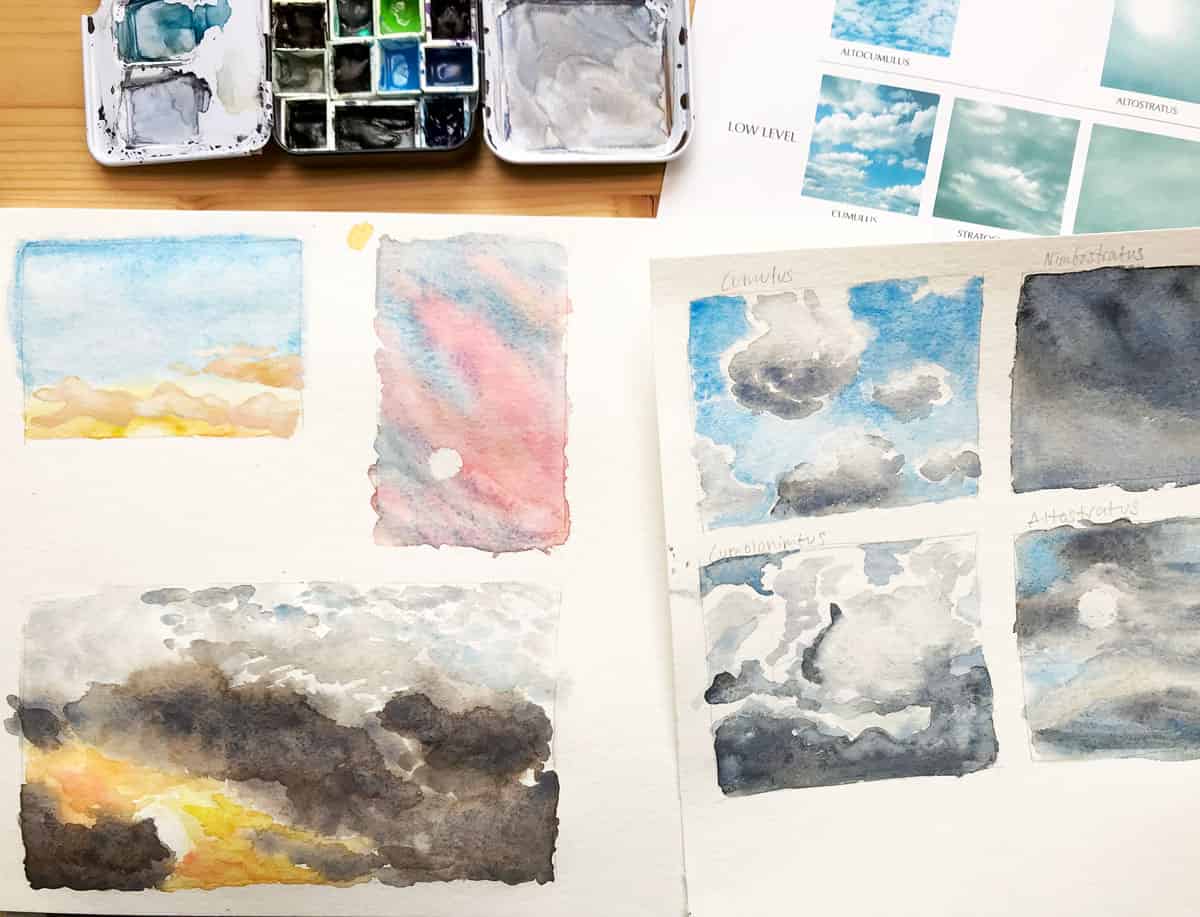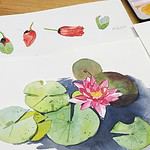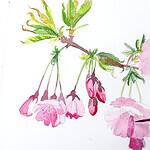Painting clouds and skies can be deeply meditative, and I love to do it especially in the morning, and in little breaks throughout the day. You can observe clouds everywhere, and the sky can always be your subject. I have dedicated pages in the front and back of my nature journal for documenting the sky, and it makes for a wonderful journey through a part of the year.
The German painter Werner Tübke (see some of his work here) once said in an interview: “I always start with the sky.” I always kept this quote in mind, and I find it not only practical advice, but a philosophical way to look at things. Clouds and sky are places to rest the eyes on, start thinking processes, and a wonderful subject to observe and relax. Taking time to gaze into the sky and to the horizon can give us a sense of being a small part of this world, and the way they are always different is exciting and soothing at the same time.
On a more practical level, there are different ways to paint clouds. Watercolor is a great medium for depicting the sky (although thinly layered oil is also wonderful, as is a good photography), and you can quickly put your impressions of clouds onto paper.
Watercolor pigments for sky
Some watercolor pigments seem to be made for sky colors, and it’s worth taking a close look at your blues and making some swatches to see which one matches your local sky best. The color of the sky differs a bit in different parts of the world, and also depends on your standpoint, the time and place, and while I love Cerulean Blue (PB36) and Cobalt Blue (PB28) for „my“ sky here in Germany, other painters might prefer Ultramarine (PB29), Cobalt Azure (PB35), mixes with Phthalo Blue (PB15) or Indanthrone Blue (PB60) for dramatic dark mixes. Some of these pigments have a beautiful granulation, which makes for a very natural looking sky.
In the mornings and evenings, the sky can take all kinds of intensely red, pink, yellow and orange colors, especially in the evenings you will see gradients between the intense sunset colors and the blue layers of the sky, darkening bit by bit. With watercolor, there’s always the problem of not mixing these too much with the blue you might still see – otherwise the sky will turn green, a color you will never observe for the sky (except when you happen to watch the aurora borealis).
Painting Clouds
Clouds seem difficult to paint at first, because they are white, and usually so is the paper, so you’ll have to paint around them to make them visible. If you take a closer look you will notice that clouds do have darker parts too, even the fluffy white cumulus clouds – the flat bottom these clouds have is where you can locate the dew point, meaning the spot where water vapor condenses into liquid water.
Clouds can also have different colors, although these are usually more muted. Light greys, yellows, blues, or pinks, or in the case of intense sunset you might see intensely orange and pink clouds. It all depends on the light. Clouds also come in different shapes and names, and these can be painted with different watercolor techniques. Observing and learning these shapes will not only make you a big cloud nerd, but you will gain a better understanding of the natural world around you – you might even be able to tell the next rainstorm arriving, or that the weather will decline the next day. Of course you don’t need to know any scientific terms to paint a beautiful sky with clouds, but it’s a helpful tool and can make nature journaling more interesting: it’s another way to get closer to nature.
If you want to explore painting clouds more deeply, I explain the most common techniques for sketching and painting clouds in detail in my online course on painting clouds. I demonstrate how to paint different types of clouds and skies (sunny weather, thunderstorm, sunset, and more), and I also explain basic cloud anatomy so you can learn the names of what you paint.
The Shape Of Clouds
Clouds can have a multitude of shapes, but there are also a few rules. Clouds actually follow perspective and foreshortening rules, so everything that’s close to you will be more round, detailed and irregular, while clouds closer to the horizon seem flatter and compressed. You actually see these clouds from the side. Also note that clouds very rarely have cartoon-like shapes. The key to draw convincing clouds is to make the edges irregular – like everything in nature, you will make a better sketch of you really look at a shape and don’t give in to the schematic approach you have in your head.
Painting the sunset
Sunsets are great to watch and a wonderful end to the day. Particularly in the colder months you can watch spectacular sunsets. To keep a sunset sketch luminous and colorful, there are a few tricks. The first thing you need to embrace is to exaggerate the contrasts – you will need to make the dark areas a lot darker than what you can still see with your eye to make the color of the sunset pop. Remember that your paper can never shine as brightly as the sun, so you can only suggest the light and the glow in the sky. Squint your eyes to get a better idea of the values (and don’t look directly into the sun).
Another technique is not to put blues and reds on top of each other – since watercolor is transparent and the paint layers will mix, you will get a muddy brown layer or cloud. Yet often we can observe a sky that’s blue on the top, and bright orange where the sun just disappeared behind a mountain. How do you paint this? The trick is to make two graded washes, so that the colors will gradually fade out, and barely mix in the middle where they will meet.
To add luminous orange or pink clouds on top of your blue sky, you have to be a bit more resourceful. You either have to leave a white space and paint around your cloud shapes, or you will have to do an underpainting – gouache is the most helpful medium for this, as it’s fully compatible with watercolor. You can either use white gouache and then add the color of the cloud with a light watercolor wash once it’s dry, or directly work in the gouache color you see.
I hope you’re looking forward to gaze at the sky now from time to time, or maybe this has activated your cloud nerd genes. In any case, I hope you’ve gotten a few practical tips on how to tackle painting the sky and clouds.
If you still want more, check out my cloud painting class. The class is available on Gumroad (with pay-what-you-want pricing) or through Skillshare.
Have I forgotton anything you’d like to know? Let me know in the comments!







Cloud nerd genes activated! Excellent! Excellent! I really enjoyed this article! It is true, one can start to be able to tell the weather by watching the sky. Keeping a sky log sketchbook helped me to see patterns and record unusual colors. Thank you for always inspiring, Julia.
Sky log sketchbook is a wonderful name for it!
hi Julia,
FYI – Just a quick note to let you know there is one time that clouds ARE green. This is when they are above the the Great Barrier Reef (Australia) on a clear and windless day – and what you are seeing are the coral and sand and sea reflected into the clouds. You can actually navigate like this. This is where I work, so I have seen it often. (You, on the other hand wouldn’t have). Thought you might find this interesting….
Yours in Sketching,
Lisa
Ooh, Lisa, that’s fascinating, thank you for sharing! Indeed, I hadn’t heard about this phenomenon. You never stop learning about these kind of things.